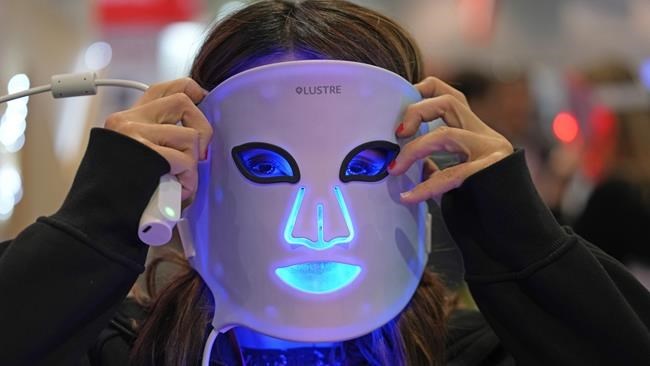
Kimberly Lafleur from LUSTRE ClearSkin wears the revive mask at the company booth during the CES tech show in Las Vegas, Friday, Jan. 6, 2023. One in 10 Canadians spend more than $500 on skin care every year, but it isn't as simple as opting out, especially for women. THE CANADIAN PRESS/AP-Rick Bowmer
Republished July 11, 2023 - 11:06 AM
Original Publication Date July 11, 2023 - 10:21 AM
Every morning, 31-year-old Natalie Ast wakes up, splashes some water on her face, and begins her morning skincare routine.
First, she massages her face with a stone tool known as a gua sha. Then she applies the following products: vitamin C serum (good for breakouts), a hyaluronic acid serum (great for moisturizing), two moisturizers (one for acne, one for tint) and sunscreen (her grandma always insisted on it).
Overall, her skincare products cost approximately $122 per month, or about $1,460 per year.
While skincare routines can add up, it's not always easy to cut back on spending when it's going towards the maintenance of our most visible feature.
“I want to take care of what I have, investing here and there on certain products that make a difference in my routine,” Ast says. “Hopefully (I) can avoid needing to go to a professional esthetician for facials and peels and more expensive treatment.”
The size of the market speaks to how much importance people put on their routines. Canada's cosmetics market, which includes skincare products, generated about $1.65 billion of revenue in 2021, according to the U.S. International Trade Administration. It expects the market to reach $2.4 billion by 2024.
It isn't necessarily as simple as opting out of the expense entirely, especially for women. A 2016 study by University of Chicago sociologist Jaclyn Wong and the University of California Irvine's Andrew Penner found that while attractiveness was linked to higher incomes for both men and women, personal grooming boosted earnings for all women. Personal grooming includes “beauty work” like makeup, hair cuts or Ast’s morning routine.
“Being attractive is not enough,” Wong wrote about her study in a blog post for the American Sociological Association. “It is doing attractiveness appropriately that gets rewarded in the workplace.”
Ast agreed to detail the skincare products she uses for her morning, nighttime and weekly routine for The Canadian Press, as well as how often she restocks each item. Her purchases range from $1.99 for eye makeup remover to $208 for a vitamin C serum, a concentrated liquid that promises to better hydrate skin, smooth wrinkles and otherwise hide signs of aging.
Ast is among the one in 10 Canadians who spend more than $500 on skincare every year, according to a 2020 survey by MoneySense and T-Zone. Nearly half of Canadians spend between $100 and $499 on skincare per year, with the remaining 40 per cent or so spending less than $99.
The price of a skincare routine differs depending on an individual’s budget and needs, says Vancouver dermatologist, Dr. Monica Li. She recommends focusing on three skincare products a day: cleanser, moisturizer and sunscreen. Gentle, fragrance-free versions of these products protect the skin barrier and upkeep skin health, she says.
Li doesn’t dissuade her patients from purchasing expensive creams, but only if they don’t hurt the skin and the patient can comfortably afford them. If someone can’t afford something like a $500 cream, she doesn’t think it means they’re due for bad skin.
“It really does not need to be expensive. Expensive does not mean quality,” Li says. “In terms of the cost of skin care, sometimes people make choices because it makes them happy.”
Jessica DeFino can relate. DeFino used to work in the beauty industry, including for apps from Khloé Kardashian and Kendall Jenner, but now writes The Unpublishable, a newsletter for her "pro-skin, anti-product" reporting and critiques of the beauty industry.
DeFino started noticing the skincare industry’s hold on happiness when she did a month-long cleanse from all skincare and makeup.
“I started asking myself: why do I feel so worthless without these products? Because that feels like a problem,” she says. “If I don't feel free to move through the world without beauty products, that points to a much deeper issue.”
DeFino knows how hard opting out of skincare can be. She only did sowhen her dermatitis treatment stopped working, leaving her skin red, rough and peeling.
DeFino emphasizes that not everybody can completely opt out of beauty and skincare culture. Individual social and financial circumstances will determine how much this is possible.
Ast has recently reduced her skincare spending. She wants to be more holistic about her health, like focusing on eating less meat, rather than exclusively relying on products. A nutritious diet, consistent exercise and regular sleep play big roles in preventing skin disease, a 2022 University of Colorado study found.
“I think people get caught up in thinking that the products are going to solve their problems, and oftentimes it doesn't,” says Ast. “Do you really need it or is this a TikTok fad that inspired you to spend more money?”
This report by The Canadian Press was first published July 11, 2023.
News from © The Canadian Press, 2023